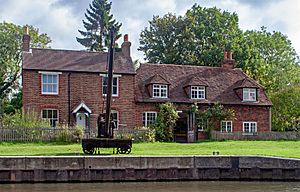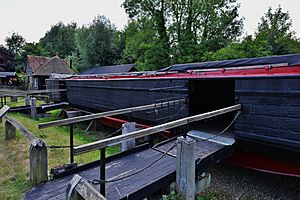Dapdune Wharf facts for kids
Quick facts for kids Dapdune Wharf |
|
|---|---|

Steam launches at Dapdune Wharf
|
|
| Type | Wharf and boat-builders yard |
| Location | Wharf Road, Guildford |
| Area | Surrey |
| Owner | National Trust |
| Lua error in Module:Location_map at line 420: attempt to index field 'wikibase' (a nil value). | |
Dapdune Wharf is an old industrial wharf and boat yard. It is located on the Wey and Godalming Navigations in Guildford, England. Today, the National Trust looks after it.
Long ago, Dapdune Wharf was a busy place where goods were moved from boats to land. Before the Godalming Navigation was built, important items like timber from Surrey forests and gunpowder from Chilworth were transported here. The gunpowder could not go through Guildford town. For a while in the early 1900s, Dapdune Wharf was famous for building barges for the Wey Navigation.
Now, Dapdune Wharf is a fun place to visit. You can start boat trips from here or even rent a boat. The Visitor Centre has cool interactive displays. You can also see a smithy (where metal is shaped), a stable, and two of the last three Wey barges in the world. One barge, the Reliance, is in a dry dock. The other, Perseverance IV, is still floating but needs repairs.
Dapdune Wharf is also the main office for the Navigation. The National Trust has volunteers who research and share information about the Godalming and Wey Navigation. This helps preserve British history.
Contents
Exploring the Wharf Buildings
Dapdune Wharf has about twelve buildings. Most of them were used for building and fixing barges. They also stored materials needed for the boats.
- There is a smithy for metalwork.
- A barge repair shed is at the end of a short river channel.
- The carpenters' shed was once a place for making sails.
- The barge building shed is at the north end of the site.
- There was also a dry dock for fixing barges below the water.
- Separate buildings stored gunpowder and carbide (a fuel for lamps).
- Two special buildings were a steam chest for bending wood and a tar chest for sealing boats.
A cottage on the wharf, renovated in 1894, is a Grade II listed building. This means it is a historically important building. The other cottage, Dapdune Lea, was built for Mary Jane Stevens. Her brother, John, later added a balcony to watch cricket. Dapdune Lea is now the National Trust's office for the navigations.
Building Barges at Dapdune
The Wey Navigation opened in 1653. Boat traffic grew very quickly. In its first year, the owners collected £800 in tolls. This quickly grew to £15,000 each year. This growth happened because many mills were built along the Wey. Also, other ways of transport were very slow. One of the biggest mills was at Coxes Lock, near Addlestone.
In the early days, local landowners and business people owned the Navigation. Sir Richard Weston first thought of making the Wey river suitable for boats. By 1723, the Langton family and the Earl of Portmore owned the Navigation.
Two families, the Stevens and the Edwards, were very important for the river and barge building.
The Stevens Family's Role
For 150 years, the Stevens family helped develop the Wey Navigation. They started as lock keepers. Then they owned and managed a big transport business. Four generations of the family worked with the Navigation.
- William Stevens (1777–1856)
William was a carpenter. He moved to the Wey in 1812 to be a lock keeper. In 1820, he moved to Thames Lock. This lock was the entry and exit point for the Navigation. So, William had more duties, like calculating tolls. This is where he learned about the business side of things.
- William Stevens II (1810–1890)
Born on the river, William followed his father into the business. He started building and operating his own barges from 1840. William learned his skills by working as an apprentice in several boat yards. His family moved to Guildford. One of their early barges, Perseverance, was built in 1840. Many barges had this name, but only Perseverance IV was built at Dapdune.
- William Stevens III (1844–1936)
William III brought the Edwards family to the Navigation. He started building Wey barges at Dapdune. William also ran steam tugs and a towing business on the River Thames. In 1902, the Stevens brothers took full control of the Navigation.
- Harry W. Stevens (1887–1970)
Harry was the last family member involved with the Navigations. When he retired in 1964, he gave the Wey Navigation to the National Trust.
The Edwards Family's Contribution
In 1894, William Stevens asked Edwin Edwards, a barge builder, to move his family to Dapdune. Edwin had four sons and several daughters. They moved from the Kennet and Avon Canal. The Stevens family gave Edwin and his family a cottage on the site. Before coming to Guildford, Edwin worked for a company that made wooden barges.
Edwin died in 1904 at age 46. Five years later, in October 1909, William Stevens III launched a new barge called Dapdune. Edwin's four sons built this barge in their free time. Their main job was maintaining the Navigation, especially the locks. Dapdune was used until 1944.
After 1909, the Edwards brothers continued to build barges for the Stevens family part-time. They completed eleven barges over the next thirty years. Besides their duties on the Navigation, the Edwards brothers also fixed and maintained the barges.
How a Wey Barge Was Built
The Wey barge design came from earlier western barges. The first barges made for the Wey were probably built at Honey Street Wharf, Devizes. This could have happened around 1810, when the Kennet and Avon Canal opened.
The curved parts of the hull (the boat's body) were made from oak wood. There was a steam chest where wood could be bent into shape. However, the Edwards family preferred to find wood that was naturally curved.
The hull was covered with pitch pine planks. Pitch pine was used because it was light and came in long pieces, so fewer joints were needed. Elm wood was tried, but it was heavier. This meant the barge could carry less cargo.
The Wey barge had a flat bottom and straight sides. This design allowed it to carry a good amount of cargo in shallow water. Once the hull was finished, it was covered in pitch to make it waterproof. The barge was built on stands to keep it off the ground and help with launching. Only the hull was built inside the shed. When it was ready, the river-facing side of the shed was removed, and the barge was launched sideways into the water. Then, the barge was towed to another area where the rest of the boat was finished. This area was also used for repairs.
A Wey barge was about 22.5 metres (74 ft) long. Its width was limited to 4.3 metres (14 ft) by the narrowest lock. A barge would have only a few centimeters to spare when going through a lock!
A Wey barge could carry 80 tonnes of cargo from the Thames to Coxes Mill. From Coxes Mill upstream to Guildford, the capacity was reduced to 50 tonnes. For the journey to Godalming, it was even less because the water was shallower.
Goods Carried by Barges
Many different goods were transported along the Navigation, such as:
- Wheat grain or barley from Royal Victoria Dock in London to Coxes Mill.
- Gunpowder from Chilworth to Barking or Woolwich.
- Wood pulp from London docks to Woking paper mill.
- Timber from Guildford to London.
The barges did not have engines or sails. They were pulled by horses or people. Sometimes, they were pushed with poles or rowed. Once a Wey barge reached the Thames, tug boats would pull it. The horses rested in stables along the Navigation. The Navigation owned three stables. Bargemen paid to use these stables. Local inns along the towpath also provided places for horses to rest.
See also
- Canals of the United Kingdom
- History of the British canal system
- Wey barge Perseverance IV



